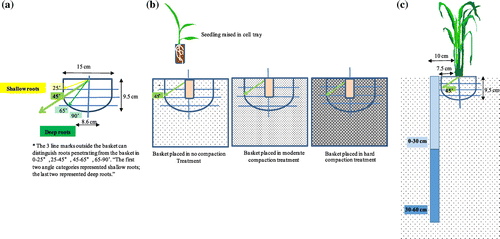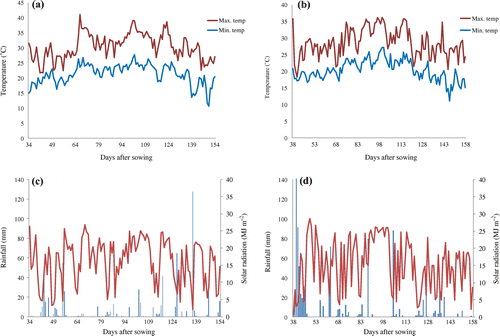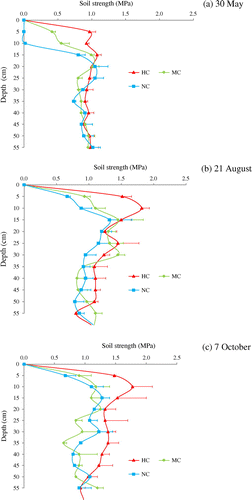Figures & data
Figure 1. Diagrams of (a) the size and geometry of the baskets used in the root basket method for counting root numbers from 0° to 45° (shallow angles) and 45° to 90° (deep angles); (b) a seedling raised in a nursery cell tray and transplanted into a basket in the field at one of the three soil compaction levels (no compaction, moderate compaction, and hard compaction); and (c) placement of the basket and the position of the corers used to obtain samples at depths of 0 to 30 cm and 30 to 60 cm.

Figure 2. Daily minimum and maximum air temperatures (°C) in the (a) 2013 and (b) 2014 experiments, and daily rainfall (mm) and daily cumulative solar radiation (MJ m−2) in the (c) 2013 and (d) 2014 experiments.

Figure 3. Profile of soil strength (resistance to penetration) in the three soil compaction treatments on (a) 30 May (33 DAS), (b) 21 August (116 DAS), and (c) 7 October (163 DAS) 2014. Bars indicate standard error.

Figure 4. Time course of soil-water potential in no compaction (NC), moderate compaction (MC) and hard compaction (HC) treatments from 26 June to 6 October 2014.

Figure 5. Profile of root length density (RLD) at a depth from 30 to 60 cm for the three genotypes (IR64, Dro1-NIL, and Kinandang Patong [KP]) on 19 October (126 DAS) 2013. IR64 and Dro1-NIL were significantly different (t-test, n = 3, p < .05); KP could not be compared with the other genotypes because it was not replicated. Values are mean ± standard deviation.
![Figure 5. Profile of root length density (RLD) at a depth from 30 to 60 cm for the three genotypes (IR64, Dro1-NIL, and Kinandang Patong [KP]) on 19 October (126 DAS) 2013. IR64 and Dro1-NIL were significantly different (t-test, n = 3, p < .05); KP could not be compared with the other genotypes because it was not replicated. Values are mean ± standard deviation.](/cms/asset/d2bd0716-5b45-427b-9c7f-bbd9d5fb8648/tpps_a_1288550_f0005_b.gif)
Table 1. Total numbers of roots in the two growth angle categories (0° to 45° and 45° to 90° from the horizontal) and proportions of the total in these categories for IR64, Dro1-NIL, and Kinandang Patong on 19 September (140 DAS) (2013 (mean ± standard error). We calculated the least-significant difference at p < .05 (LSD.05).
Table 2. Root numbers and proportions of the total for the two growth angle categories (0° to 45° for shallow angles, 45° to 90 for deep angles) for IR64, Dro1-NIL, and Kinandang Patong in the three compaction treatments: no compaction, moderate compaction, and hard compaction (mean ± standard error). We calculated the least-significant difference at p < .05 (LSD.05). (a) 23 July 2014 (around maximum tillering).
Figure 6. Comparison of the root length density (RLD) at a depth from 30 to 60 cm among the three genotypes (IR64, Dro1-NIL, and Kinandang Patong [KP]) in the three soil compaction treatments: no compaction, moderate compaction, and hard compaction. Data were obtained on 2 September (128 DAS) 2014. Values are mean ± standard deviation (n = 3). For a given compaction treatment, bars labeled with the same letter differ significantly (p < .05, Tukey’s LSD test.
![Figure 6. Comparison of the root length density (RLD) at a depth from 30 to 60 cm among the three genotypes (IR64, Dro1-NIL, and Kinandang Patong [KP]) in the three soil compaction treatments: no compaction, moderate compaction, and hard compaction. Data were obtained on 2 September (128 DAS) 2014. Values are mean ± standard deviation (n = 3). For a given compaction treatment, bars labeled with the same letter differ significantly (p < .05, Tukey’s LSD test.](/cms/asset/98d9c5a6-ca02-4b23-b1bb-5f6557a19c1b/tpps_a_1288550_f0006_b.gif)
Figure 7. (a) Relationships between the number of roots around maximum tillering and at maturity for roots with shallow (s) and deep (d) angles in the no compaction (NC), moderate compaction (MC), and hard compaction (HC) treatments. (b) Relationship between proportion of roots with a deep angle around maximum tillering and root length density (RLD) at a depth of 30 to 60 cm. (c) Relationship between the proportion of roots with a deep angle around maximum tillering and the proportion of total RLD at a depth of 30 to 60 cm. Values are for both 2013 and 2014, for all three rice genotypes (IR64, Dro1-NIL, and Kinandang Patong [KP]) across the three compaction levels in 2014 and in the no compaction treatment in 2013. Only statistically significant linear regression lines are shown. **p < .01; ns, not significant; n = 12.
![Figure 7. (a) Relationships between the number of roots around maximum tillering and at maturity for roots with shallow (s) and deep (d) angles in the no compaction (NC), moderate compaction (MC), and hard compaction (HC) treatments. (b) Relationship between proportion of roots with a deep angle around maximum tillering and root length density (RLD) at a depth of 30 to 60 cm. (c) Relationship between the proportion of roots with a deep angle around maximum tillering and the proportion of total RLD at a depth of 30 to 60 cm. Values are for both 2013 and 2014, for all three rice genotypes (IR64, Dro1-NIL, and Kinandang Patong [KP]) across the three compaction levels in 2014 and in the no compaction treatment in 2013. Only statistically significant linear regression lines are shown. **p < .01; ns, not significant; n = 12.](/cms/asset/2f832517-8758-4da2-b08e-51711e011c65/tpps_a_1288550_f0007_oc.gif)